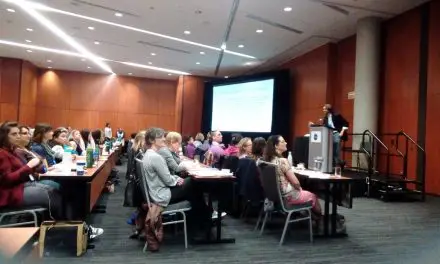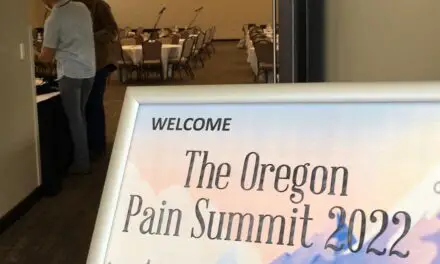The third annual Oregon Pain Summit will be held on Jan. 22-23, 2021, and like most conferences in 2020, this will be held virtually because of the Covid-19 pandemic. Unlike the previous two summits that focused more on patients and public health, the upcoming event will focus more on clinicians and caregivers with the theme “Pain, Compassion, and the Clinician.”
“That means if the clinicians can understand compassion, they should take care of themselves before they can take care of patients. We’re just draining ourselves out,” explained Dr. Sharna Prasad, who is a physical therapist at Samaritan Health Services in Lebanon, Oregon, and a cofounder of the Oregon Pain Summit.
Masters of Ceremony Michael Falcon and Joletta Belton will be moderating the summit and will connect each presenter’s stories throughout the two-day event. “They will share their patients’ narratives while the speakers will be looking at it from a population perspective, like societal pain and social justice,” said Prasad.
Speakers on the first day will include:
- Dr. Kevin Cuccaro, Dr. Winston Kennedy, Dr. G. Lorimer Moseley, and Dr. Prasad, who will present various pain topics that bridge research with practice;
- Shelly Prosko on compassion in practice;
- Dr. Brent Godek and Dr. Lance McQuillan on pain science from the medical practice perspective;
- Dr. Melissa “Missy” Cheyney on how different cultures perceive and understand pain;
- Linda Crawford on the “lived experiences” of people in chronic pain;
- Tina Corey on how she illustrates pain to her patients with a whiteboard.
Cuccaro, who is a practicing osteopathic physician and pain specialist in Corvallis, Ore, will kick off with his talk about the “protection and construction” nature of pain.
“If you understand those two things really well, everything falls into place,” Cuccaro said in a phone interview. “If you think pain is only a damage indicator, and you reframe it into a protective or warning mechanism, that would change how you think about pain.”
Cuccaro compared such thinking with a plumber and firefighter mentality. A plumber approach would attempt to fix the problem by finding its source, while a firefighter approach has a more constructive approach where there are multiple potential causes of the problem, not just one.
Although most of the Oregon Pain Summit will have very little interaction among the attendees, one presentation will have some “mingling.” Crawford’s talk will have participants engage in breakout sessions where they practice the various teaching methods they learn in her talk.
“People need real life lessons, real life experiences, and real life applications in order to be empowered with the skills they need to successfully self-manage their pain and self-direct their lives,” Crawford explained. “What can we learn by singing a song in German together? Making scribbles on a piece of paper? Investigating the lived experience of our daily activities?
“How can you design experiential education activities and adapt them for different ages, cultures, and literacy levels? Join in on the fun and find out!”

Speakers and MCs from the 2020 Oregon Pain Summit. (Photo courtesy of Sharna Prasad.)
The idea of the Oregon Pain Summit began in 2016 with Prasad and few of her colleagues who had attended that year’s opioid conference. Then they decided to use the format of that conference and turn it into a pain conference that is targeted to the state of Oregon. Prasad presented the idea to the Oregon American Physical Therapy Association (APTA) and expanded the audience to physicians.
“It’s very stressful because we got used to doing it traditionally,” Prasad said. “Having everything is a big challenge, especially coordinating the organization among five clinicians who have limited technology experience. We’re keeping our fingers crossed because we have no idea how it will turn out.”
The first Oregon Pain Summit had about 100 attendees with more than half of them were physicians. The rest of the audience are physical therapists, massage therapists, and occupational therapists. The summit had a few sponsors to support the pain summit, including PainWise, which is a Samaritan Health Services subsidiary.
“I asked [PainWise], ‘Would you sponsor it?’ ‘Sure,’ they said. Everybody agreed. They paid for three meals a day and endless coffee,” Prasad said.
The 2020 Oregon Pain Summit had a significant number of massage therapists who attended, thanks to Mark Retzlaff, who is a licensed massage therapist (LMT) and the Government Relations Chair for the American Massage Therapy Association’s Oregon chapter. (AMTA)
“Sharna reached out to me about helping to promote the summit among massage therapists,” Retzlaff said, “I shared the event on local massage therapy Facebook groups and reached out directly to some LMTs I knew who had an interest in pain science. The summit was able to offer a very generous scholarship for massage therapists, which made the event much more accessible to us. I would estimate around eight LMTs attended the first year and 15 in the second, which is a much higher representation relative to other interprofessional conferences I’ve attended locally.”
[Read: Why Massage Therapists Should Understand How Pain Works]
Prasad recalled that the 2020 Oregon Pain Summit was “the best year.” With about 200 people in attendance of the theme trauma-informed care, it hosted a narrative medicine feature with Lissanthea Taylor, who is a cofounder of Pain Revolution in Australia, and Dr. Melissa Cady and her husband Corey Jackson on humor and pain.

Corey Jackson (l) and Dr. Melissa Cady on using humor with pain management. Photo courtesy of Sharna Prasad.
“After every presentation, we cried because they got to us emotionally. The speakers were very vulnerable and authentic, that’s what we got,” Prasad said.
“I’m really excited that Joletta Belton and Michael Falcon are hosting the event since both are talented presenters and bring critical perspective as patients,” Retzlaff said. “The most impactful conference sessions I’ve attended have been when patients have had a chance to address healthcare providers directly about what we need to know and how we can improve. The format for the Oregon Pain Summit builds time between each presentation for the moderators to connect clinical practice to the patient perspective. I’m really interested to see how this goes.”
“Pain is complex and weird, but there’s a lot of hope that we can bring to our communities,” Prasad said. “My biggest hope is that this will start similar conferences in other clinicians’ communities. Each community will have different populations and societal factors that affect different people’s pain, so bringing different experts from different countries and cultures. Focus on the local population while bringing international experts.”
“I’m also hopeful that LMTs from around the country will be able to attend the summit since it is online this year,” Retzlaff said. “There is a strong and growing pain-science community here in Oregon, and it is exciting to share that with people from around the world.”
For more information about the 2021 Oregon Pain Summit, email Dr. Sharna Prasad at Sprasad@samhealth.org.
Sign up at EventBrite.

Photo courtesy of Sharna Prasad.
A native of San Diego for nearly 40 years, Nick Ng is an editor of Massage & Fitness Magazine, an online publication for manual therapists and the public who want to explore the science behind touch, pain, and exercise, and how to apply that in their hands-on practice or daily lives.
An alumni from San Diego State University with a B.A. in Graphic Communications, Nick also completed his massage therapy training at International Professional School of Bodywork in San Diego in 2014.
When he is not writing or reading, you would likely find him weightlifting at the gym, salsa dancing, or exploring new areas to walk and eat around Southern California.






